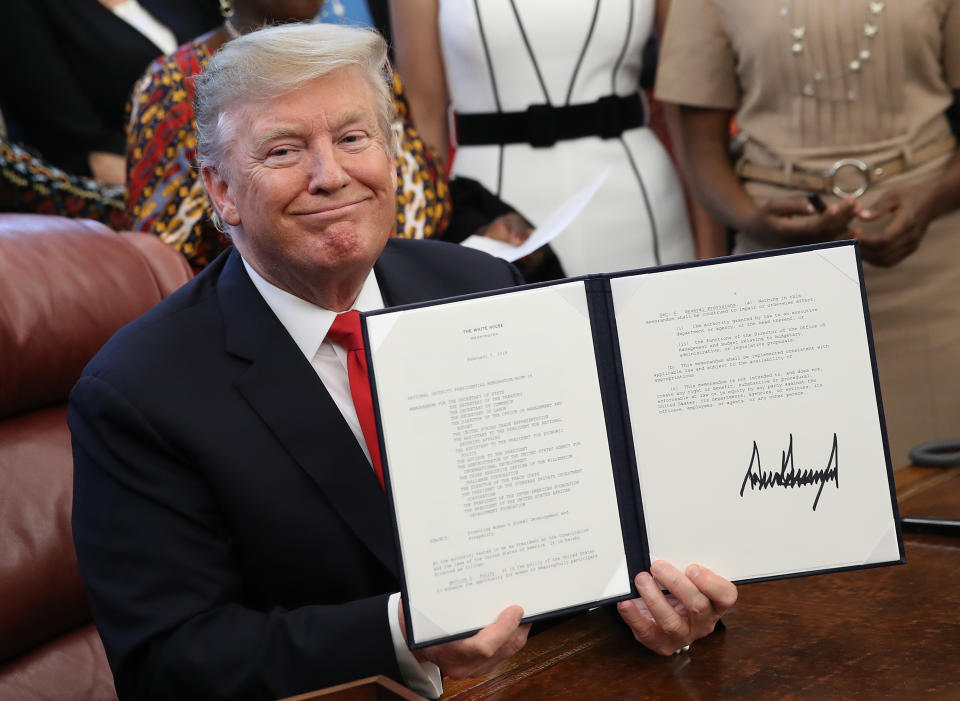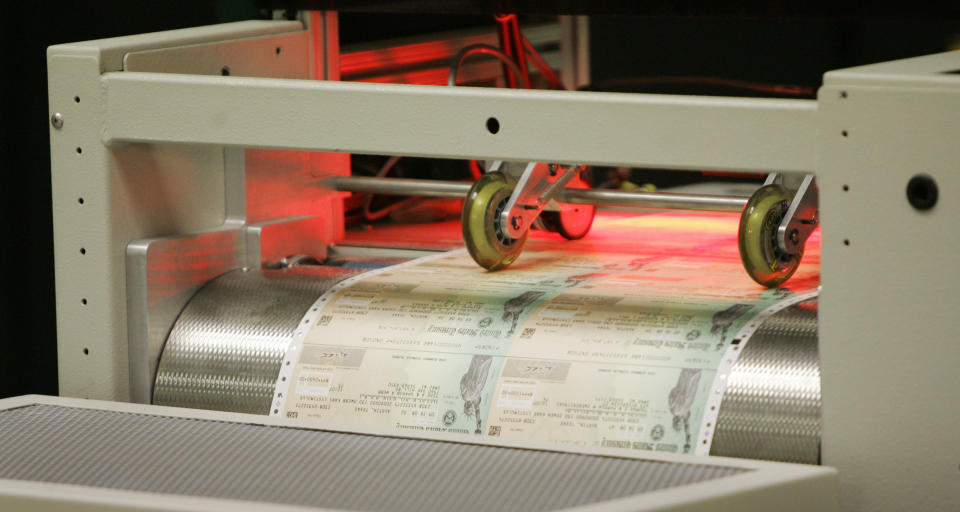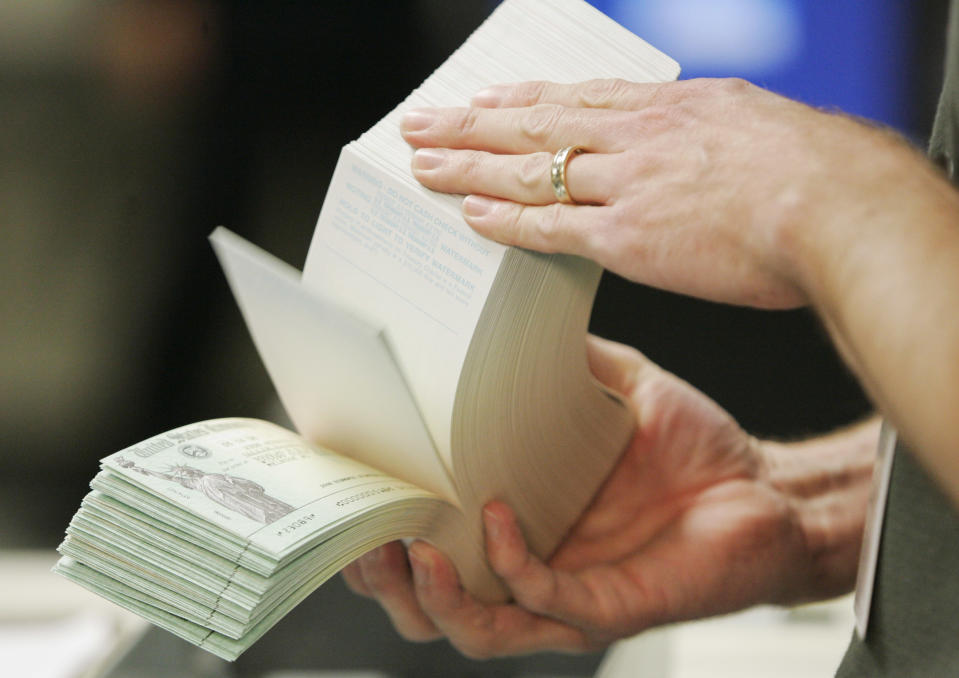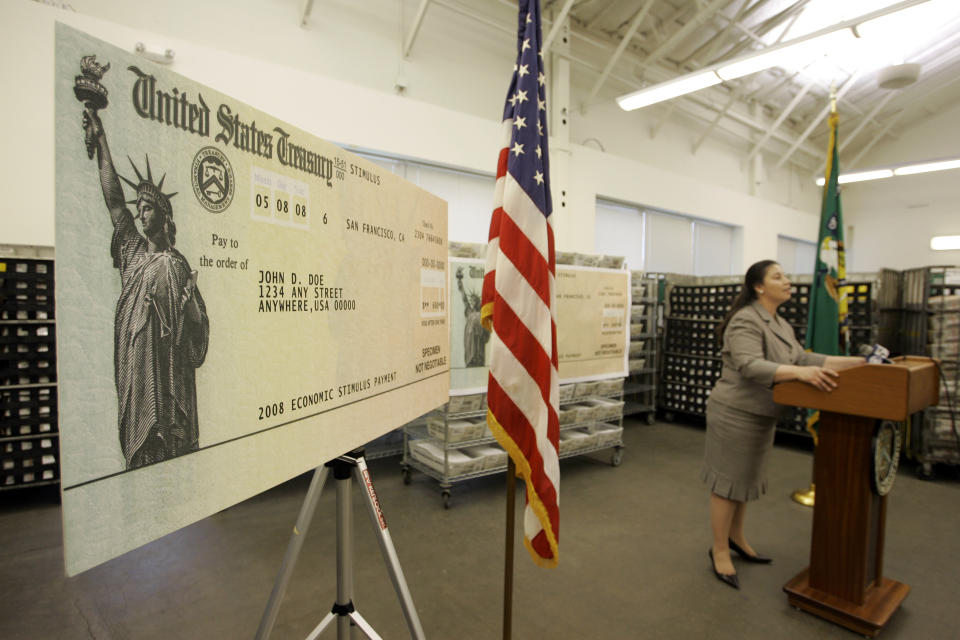Coronavirus stimulus checks: Trump signature scramble could delay first batch
While over 80 million Americans are expected to receive a stimulus deposit by the end of this week, some Americans could see a delay for their paper checks after the Treasury Department ordered that President Donald Trump’s name to be included on the printed checks.
Chad Hooper, national president of the IRS-founded Professional Managers Association (PMA), told Yahoo Money that "reprogramming historically has led to delays. Our team at IRS always works very diligently to mitigate and minimize those delays.”
Mark Everson, a former IRS Commissioner and now the vice chairman of alliantgroup, said that this addition would qualify as a programming change that requires testing.
Read more: Coronavirus stimulus check scams: How to avoid becoming a victim
“Anytime you have more changes from what you’ve done before, you’ve got to test it,” Everson told Yahoo Money. “So by definition, it involves time. The difficulty of that task is compounded by the fact that they’re not fully staffed [because] they’re not in the office doing a lot of this work. They’re stretched in the technology area and they’re under a tight timeline.”
The design is scheduled to be delivered to the Bureau of Fiscal Service for printing and issuing on Thursday morning. The Treasury denied that the checks will be delayed.
The checks “are scheduled to go out on time and exactly as planned — there is absolutely no delay whatsoever,” a Treasury spokeswoman told Yahoo Money, noting the first checks will be mailed early next week.

However, two members of the PMA with direct knowledge of the situation told Hooper that this would lead to a delay.
“They were not able to speak to the expected duration,” Hooper said. “In that sense, the Treasury’s position that there will not be a delay is plausible. The situation is fluid and our team works around the clock to try to make changes which would mitigate impact.”
President Trump accused of causing delay ‘to feed his ego’
The first batch of printed checks is expected to arrive by April 24. If they’re delayed, it may be only the first ones that are impacted because the paper checks will be issued weekly, according to Hooper.
The Washington Post first reported the request to add President Trump’s signature.
The president’s printed name will appear on the left side of the paper check, the first time a president’s name will be printed on an IRS disbursement, according to the Post’s reporting. Various parties in D.C. are not happy with the move.
Read more: Coronavirus stimulus check: How to get one if you don’t file your taxes
“It’s outrageous, we already know that folks who are not in the system for electronic deposit will have to wait longer to get their check sent in the mail to them,” Sen. Gary Peters (D-MI) told Yahoo Money. “Now that he’s adding his name those checks will be delayed further.”
A spokesperson for the Ways and Means Committee told Yahoo Money that the committee “was not consulted about this, and we do not want the checks to be delayed for a second to add the signature.”
Senator Ron Wyden of Oregon, the top Democrat on the Finance Committee, asserted to the New York Times that “Donald Trump is further delaying cash payments to millions of Americans struggling to pay the rent and put food on the table to feed his ego.”

Read more: How to file taxes: The full breakdown
As part of a $2 trillion coronavirus relief package, many Americans will get government checks up to $1,200 — plus $500 per child — to help them ride out a job loss, reduced work hours, and other money challenges as the country tries to stem the pandemic.
Here’s everything you need to know about the stimulus check.
Who gets a stimulus check?
“Our updated estimate is that 93.6% of [tax] filers will have a rebate,” Garrett Watson, senior policy analyst at The Tax Foundation, said. “And this works out to approximately 140 million households.”
Your eligibility is based on your most recent tax return and your adjusted gross income. If you already filed your 2019 taxes, your eligibility will be based on that. If not, the IRS will use your 2018 taxes to determine if you qualify.
The benefit is available not only to those who have filed taxes, but also to those who receive Social Security benefits as long as they’ve received their SSA-1099 or RB-1099 forms.
Read more: Tax deadline postponed: Why you should still file as soon as you can
Single adults with income up to $75,000 will get a $1,200 payment. Married couples with income up to $150,000 will get $2,400. Single parents who file as head of household with income up to $112,500 will get the full $1,200 check.
And, Americans who qualify for the stimulus payment and have children will get an additional $500 per child under 17.
Reduced checks will be available for single adults who earn between $75,001 and $99,000 and married couples who earn between $150,001 and $198,000. The check will be reduced by $5 for every $100 over $75,000 for single adults and $150,000 for married couples.

Who doesn't get a check?
Single adults who make more than $99,000 and married couples who earn more than $198,000 won’t receive stimulus checks.
Those without a Social Security number and nonresident aliens — those who aren’t a U.S. citizen or U.S. national and don’t have a green card or have not passed the substantial presence test — aren’t eligible.
You’re also ineligible if your parents claim you as a dependent on their taxes.
How will the government send you the stimulus check?
The IRS will use the direct deposit information you provided from the taxes you’ve filed either for 2019 or for 2018.
If you have no direct deposit information on file or if the account provided is now closed, the IRS will mail you a check, instead.
When will the stimulus check arrive? It depends.
Treasury Secretary Steven Mnuchin said at a White House briefing on April 2, that those Americans who have signed up for direct deposit will receive their payment within two weeks.
“Social Security, you’ll get it very quickly after that,” Mnuchin said. “If we don’t have your information, you’ll have a simple web portal, you’ll upload it. If we don’t have that, we’ll send you checks in the mail.”
The payments will be deposited directly into your bank account if you received your last tax refund or expect to receive this year’s refund that way.
Otherwise, checks will be mailed, which could take longer to get to Americans. Adding to the complications, about 6% of U.S. adults — or about 12 million Americans — do not have a checking, savings, or other bank account, according to a 2018 Federal Reserve report.
The New York Times, citing IRS guidelines that detail how Americans who aren’t usually required to file tax returns will need to do so to receive payments, noted the guidance “will almost certainly mean longer waits for those who must file new returns to be eligible to receive a stimulus payment.”
Americans with the lowest income will get mailed checks first, according to reporting by the Washington Post. Here’s the timetable for the first checks, per IRS documents seen by the Post:
Taxpayers with income up to $10,000: April 24
Taxpayers with income up to $20,000: May 1
Taxpayers with income up to $40,000: May 15
The rest of the checks will be issued by gradually increasing income increments each week. Households earning $198,000 who file jointly will get their reduced checks on Sept. 4. The last group of checks will be sent on Sept. 11 to those who didn’t have tax information on file and had to apply for checks, according to the Washington Post.
How can those who don’t file taxes get a payment?
Americans who don’t usually file taxes can register to get their stimulus aid checks on IRS website or use Turbotax’s free tool to file a minimum tax return.
TurboTax’s tool helps determine if you’re eligible for the stimulus payment. If eligible, you need to answer a few questions and choose whether to get the payment though direct deposit or check.
“There are as many as 10 million Americans who are not required to file a tax return,” TurboTax said in a statement. “Because the IRS will use the federal tax return to determine and send individual stimulus payments, these individuals are at risk of not receiving their stimulus payment.”
Social Security recipients and those required to file tax returns don’t need to provide additional information, but still must meet the eligibility criteria to get a payment.

Can you track the payment?
Yes. Those who are still waiting can track it online. Americans will also be able to provide the Internal Revenue Service with their direct deposit information if it’s not on file with the agency.
“If you do not receive them by Wednesday, you’ll be able to put in your direct deposit information, and within several days, we will automatically deposit the money into your account,” Treasury Secretary Steven Mnuchin said on Monday. “We want to do as much of this electronically as we can.”
The agency expects to release an online “Get My Payment” tool on its website by the end of the week that tracks the status of your stimulus check. The tool will let people follow the scheduled payment date for either a direct deposit or mailed check.
The tool will also allow people to provide their bank account details to get their payment by direct deposit versus waiting for a mailed check, which don’t go out until the end of April. If you filed a tax return in 2018 or 2019 but didn’t provide direct deposit information, you’ll be able to identify yourself, input that banking information, and receive the payment in several days in your account, according to Mnuchin.
Do you have to pay back the stimulus check?
No. The stimulus payment is actually a refundable credit against your 2020 tax liability, according to Kyle Pomerleau of the American Enterprise, and is paid out as an advanced refund. That means you don’t have to wait to file your 2020 taxes to get the money.
It also doesn’t reduce any refund you would otherwise receive, Watson said.
In fact, if you don’t qualify for the stimulus check now based on your 2018 or 2019 tax returns, you may be able to qualify to take the tax credit next year when you file your 2020 taxes if your income meets the thresholds.
Jessica Smith and Ben Werschkul contributed reporting.
Denitsa is a writer for Yahoo Finance and Cashay, a new personal finance website. Follow her on Twitter @denitsa_tsekova.
Read more:
'Replaceable': Household help are left unpaid during coronavirus pandemic
'Losing $50,000 a day': This company's workers took voluntary pay cuts to prevent layoffs
Read more personal finance information, news, and tips on Cashay
Follow Yahoo Finance on Twitter, Facebook, Instagram, Flipboard, SmartNews, LinkedIn, YouTube, and Reddit.

 money
money 
